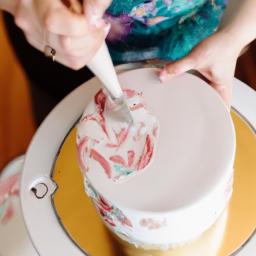Learn how to use the correct verb form of decoration in your writing and communication with our comprehensive guide. Enhance clarity and professionalism today.
As we communicate through writing, we use language to express our thoughts and ideas. However, using the wrong verb form of decoration can detract from the clarity and coherence of our message. That’s where understanding verb form of decoration comes in.
The verb form of decoration refers to the correct usage of verbs in relation to decorating objects or spaces. For example, using “paint” instead of “painted” can change the meaning of a sentence and lead to confusion.
Using the correct verb form of decoration is essential in writing and communication. It not only enhances clarity and coherence but also creates a professional and polished impression. In this article, we will dive into the basics of verb form of decoration, rules for using it correctly, tips for improving your skills, and its importance in writing and communication. Let’s get started!
Understanding the Basics of Verb Form of Decoration
Decorating objects or spaces often involves using verbs to describe actions such as painting, carving, or sewing. The verb form of decoration refers to the correct usage of these verbs in relation to decorating.
Definition of Verb Form of Decoration
The verb form of decoration involves using the correct tense, subject-verb agreement, and active vs. passive voice when describing decorating actions.
Examples of Verb Forms for Different Types of Decoration
Different types of decoration require different verb forms. For example, when describing painting a wall, the correct verb form would be “I painted the wall” rather than “I paint the wall.” Similarly, when describing adding embellishments to a dress, the correct verb form would be “I sewed on the embellishments” rather than “I sew on the embellishments.”
Common Mistakes in Using Verb Forms of Decoration
Common mistakes in using verb forms of decoration include using the wrong tense, subject-verb disagreement, and using passive voice instead of active voice. These mistakes can lead to confusion and detract from the clarity of the message. In the next section, we will discuss the rules for using verb form of decoration correctly to avoid these mistakes.
Rules for Using Verb Form of Decoration
When it comes to using the correct verb form of decoration, there are several rules to keep in mind. Let’s take a closer look at some of the most important ones:
Subject-Verb Agreement
One of the most basic rules of verb form of decoration is subject-verb agreement. This means that the verb must agree with the subject in number and person. For example, if the subject is singular, the verb should also be singular. Similarly, if the subject is plural, the verb should be plural as well.
Tense Agreement
Another important rule is tense agreement. This means that the tense of the verb should match the tense of the sentence. For example, if the sentence is in the present tense, the verb should also be in the present tense. If the sentence is in the past tense, the verb should be in the past tense as well.
Use of Auxiliary Verbs
Auxiliary verbs are verbs that help to form verb tenses, moods, and voices. They can also indicate questions, negations, and emphasis. It’s important to use auxiliary verbs correctly in order to convey the intended meaning of the sentence.
Active vs Passive Voice
The choice between active and passive voice can also affect the verb form of decoration. In active voice, the subject performs the action of the verb, while in passive voice, the subject receives the action of the verb. It’s important to use the appropriate voice depending on the context and intended meaning of the sentence.
By following these rules, you can improve your verb form of decoration skills and ensure that your writing and communication are clear and effective.
Tips for Using Verb Form of Decoration
Improving your verb form of decoration skills takes time and practice. Here are some tips to help you use verb forms correctly:
Read and Analyze Different Types of Texts
Reading different types of texts, such as books, articles, and blogs, can help you understand how verb forms are used in context. Analyzing the verb forms used in a text can help you identify patterns and rules for using verb forms correctly.
Practice Using Verb Forms in Writing and Speaking
Practice is essential to improving your verb form of decoration skills. Try writing sentences and paragraphs using different verb forms. Practice speaking and listening to others using correct verb forms in conversation.
Use Online Resources to Check for Correct Verb Forms
Online resources such as grammar checkers and verb conjugation tools can help you check for correct verb forms. Be sure to use reputable sources and double-check your work to ensure accuracy.
By implementing these tips, you can improve your verb form of decoration skills and enhance the clarity and coherence of your writing and communication. Keep practicing and learning, and you’ll be a verb form pro in no time!
The Importance of Verb Form of Decoration in Writing and Communication
When it comes to writing and communication, using the correct verb form of decoration is crucial. Not only does it help to avoid confusion and misunderstandings, but it also enhances clarity and coherence in your writing. In this section, we’ll explore the importance of using the correct verb form of decoration and how it can benefit your communication skills.
Enhances Clarity and Coherence in Writing
Using the correct verb form of decoration ensures that your message is clear and easy to understand. The right verb form helps to convey the intended meaning of your sentence, making it easier for your audience to comprehend. This can be especially important when communicating complex ideas or technical information.
Improves Understanding and Interpretation of Texts
Using the correct verb form of decoration can also improve your understanding and interpretation of texts. When reading, it’s important to pay attention to the verb forms used in a sentence as they can provide important context and meaning. Understanding verb form of decoration can help you to better comprehend the writer’s message and interpret their intent.
Creates a Professional and Polished Impression
Using the correct verb form of decoration can also create a professional and polished impression. Whether you’re writing an email, report, or presentation, using the right verb form shows that you’re knowledgeable about language and care about the quality of your work. This can help to establish credibility and respect in your professional relationships.
In conclusion, using the correct verb form of decoration is essential for effective writing and communication. It enhances clarity and coherence, improves understanding and interpretation, and creates a professional and polished impression. By understanding the importance of verb form of decoration, you can improve your communication skills and elevate the quality of your writing.
Conclusion
In conclusion, mastering the verb form of decoration is crucial for effective communication and writing. By understanding the basics, following the rules, and implementing tips, you can improve your skills and avoid common mistakes.
Remember, using the correct verb form of decoration enhances clarity and coherence, improves understanding and interpretation of texts, and creates a professional and polished impression.
As you continue to practice and improve your skills, don’t hesitate to use online resources and seek feedback from others. And if you’re looking for inspiration and ideas for decorating your space, be sure to check out decorideasblog.com.
With a little effort and attention to detail, you can master the verb form of decoration and take your writing and communication to the next level.

